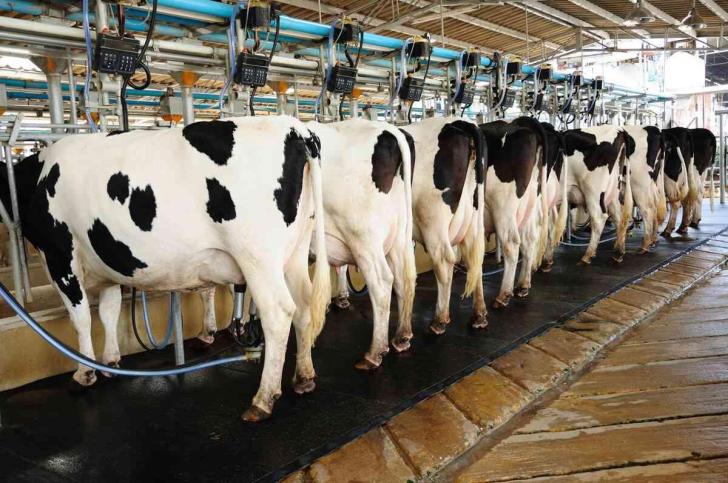News / National
Dairy farmers cry foul over low milk prices
03 Aug 2025 at 17:54hrs |
0 Views

Dairy farmers in Bubi district are struggling to stay afloat as they face a worsening mismatch between the prices offered by milk processors and the rising costs of production, particularly for supplementary feeding and water access. Despite the sector's importance to Zimbabwe's agricultural economy, many smallholder farmers say they are barely breaking even - and some are contemplating scaling down operations.
The black granite-rich district, which has traditionally relied on mixed agriculture, is now emerging as a key dairy production zone in Matabeleland North. However, the low prices offered for raw milk and the high input costs are threatening to undermine progress.
Speaking in an interview, smallholder dairy farmer Ms Sibongumusa Mthethwa said farmers in the area were receiving as little as 40 US cents per litre of milk from processors, while production costs - particularly feed - have soared.
"Milk processors are buying milk at a price as low as 40 US cents per litre despite the increase in production costs," she said. "The cost of feed and other inputs has gone up, but we are still selling the milk to the off-takers at between 40 and 55 US cents per litre. Yet, the processed milk on the market has increased to about US$1,40 per litre."
Mthethwa said her cooperative, which previously targeted daily collections of between 700 and 1,000 litres, has now seen output decline to just 400 litres a day - a worrying trend attributed largely to unaffordable inputs and declining herd productivity.
Fellow dairy farmer Mr Xolani Moyo said the burden of supplementary feeding was growing heavier each month, especially given the region's recurrent dry spells and limited grazing. He said water scarcity, in particular, was taking a toll on animal health and milk yields.
"We are calling for increased investment in borehole drilling to ensure our cattle have reliable access to clean water, a critical factor in milk production and herd health," said Moyo. "As farmers, we struggle to provide enough water for our livestock, leading to reduced milk yields, poor animal health and financial loss."
At Queens Dairy Farm, a commercial operation in Bubi, owner Mr Francesco Marconati echoed these concerns. He said they were feeding 338 dairy cows close to seven tonnes of silage daily - a figure that would jump to 90 tonnes a day if their expansion plans to 2,000 cows by 2026 are realised.
"This is our target; however, we must say the cost of supplementary feeding is affecting us," said Marconati. "Currently, we are buying from local farmers here, and it's not enough."
He said the farm was seeking additional land to set up irrigation systems to grow their own silage and reduce reliance on external suppliers. He added that Queens Dairy was also constructing a dam to hold water pumped from a nearby mine, which could help surrounding farmers access water for their livestock and crops.
While farmers are frustrated, milk processors said they were not blind to the challenges and insisted the issue was more complex than it seemed.
A representative from a leading dairy processor in Zimbabwe said processors also face mounting costs, including importation of ingredients and compliance with strict health and safety regulations.
"The issue of milk price is always a difficult matter," the representative said. "We have to process milk sufficiently so that we do not transmit diseases. We are not defending our position, but we also have costs that we cater for, so we understand the farmers' point of view."
Mrs Clementine Maregere of the Dairy Processors Association of Zimbabwe broke down the pricing structure, noting that while the farmer earns around 65 US cents per litre for milk packaged in a Tetra Pak, processors face their own production costs before the product reaches retail shelves.
"When the processor dispatches that milk at the factory level, it's going for US$1,05. The milk then goes to different retail chains, which also add their mark-ups. That's how we end up with milk selling for US$1,40 or more," she explained.
Maregere urged farmers to collaborate more, especially around feed procurement and distribution. "To address some of the challenges farmers are facing, we are encouraging them to consider joint ventures and shared investments, particularly in supplementary feeding," she said.
Dairy farming in Zimbabwe remains a key part of the agricultural economy, but the sector continues to face structural challenges. These include low herd productivity, limited access to finance, high input costs, and climate-related pressures.
Unless urgent action is taken to bridge the pricing gap and improve support for farmers, stakeholders warn that the viability of the sector - and the livelihoods of hundreds of families - could be at risk.
The black granite-rich district, which has traditionally relied on mixed agriculture, is now emerging as a key dairy production zone in Matabeleland North. However, the low prices offered for raw milk and the high input costs are threatening to undermine progress.
Speaking in an interview, smallholder dairy farmer Ms Sibongumusa Mthethwa said farmers in the area were receiving as little as 40 US cents per litre of milk from processors, while production costs - particularly feed - have soared.
"Milk processors are buying milk at a price as low as 40 US cents per litre despite the increase in production costs," she said. "The cost of feed and other inputs has gone up, but we are still selling the milk to the off-takers at between 40 and 55 US cents per litre. Yet, the processed milk on the market has increased to about US$1,40 per litre."
Mthethwa said her cooperative, which previously targeted daily collections of between 700 and 1,000 litres, has now seen output decline to just 400 litres a day - a worrying trend attributed largely to unaffordable inputs and declining herd productivity.
Fellow dairy farmer Mr Xolani Moyo said the burden of supplementary feeding was growing heavier each month, especially given the region's recurrent dry spells and limited grazing. He said water scarcity, in particular, was taking a toll on animal health and milk yields.
"We are calling for increased investment in borehole drilling to ensure our cattle have reliable access to clean water, a critical factor in milk production and herd health," said Moyo. "As farmers, we struggle to provide enough water for our livestock, leading to reduced milk yields, poor animal health and financial loss."
At Queens Dairy Farm, a commercial operation in Bubi, owner Mr Francesco Marconati echoed these concerns. He said they were feeding 338 dairy cows close to seven tonnes of silage daily - a figure that would jump to 90 tonnes a day if their expansion plans to 2,000 cows by 2026 are realised.
"This is our target; however, we must say the cost of supplementary feeding is affecting us," said Marconati. "Currently, we are buying from local farmers here, and it's not enough."
He said the farm was seeking additional land to set up irrigation systems to grow their own silage and reduce reliance on external suppliers. He added that Queens Dairy was also constructing a dam to hold water pumped from a nearby mine, which could help surrounding farmers access water for their livestock and crops.
While farmers are frustrated, milk processors said they were not blind to the challenges and insisted the issue was more complex than it seemed.
A representative from a leading dairy processor in Zimbabwe said processors also face mounting costs, including importation of ingredients and compliance with strict health and safety regulations.
"The issue of milk price is always a difficult matter," the representative said. "We have to process milk sufficiently so that we do not transmit diseases. We are not defending our position, but we also have costs that we cater for, so we understand the farmers' point of view."
Mrs Clementine Maregere of the Dairy Processors Association of Zimbabwe broke down the pricing structure, noting that while the farmer earns around 65 US cents per litre for milk packaged in a Tetra Pak, processors face their own production costs before the product reaches retail shelves.
"When the processor dispatches that milk at the factory level, it's going for US$1,05. The milk then goes to different retail chains, which also add their mark-ups. That's how we end up with milk selling for US$1,40 or more," she explained.
Maregere urged farmers to collaborate more, especially around feed procurement and distribution. "To address some of the challenges farmers are facing, we are encouraging them to consider joint ventures and shared investments, particularly in supplementary feeding," she said.
Dairy farming in Zimbabwe remains a key part of the agricultural economy, but the sector continues to face structural challenges. These include low herd productivity, limited access to finance, high input costs, and climate-related pressures.
Unless urgent action is taken to bridge the pricing gap and improve support for farmers, stakeholders warn that the viability of the sector - and the livelihoods of hundreds of families - could be at risk.
Source - Sunday Mail
Join the discussion
Loading comments…
































